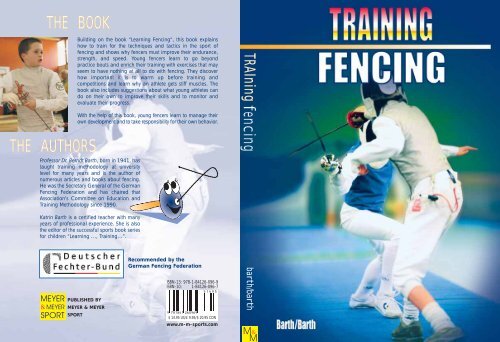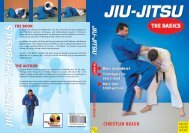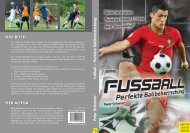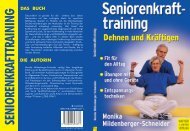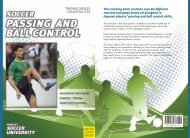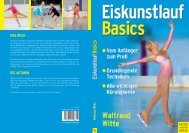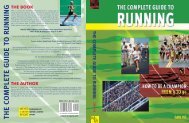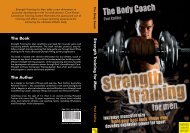You also want an ePaper? Increase the reach of your titles
YUMPU automatically turns print PDFs into web optimized ePapers that Google loves.
THE BOOK<br />
THE AUTHORS<br />
Building on the book “Learning Fencing“, this book explains<br />
how to train for the techniques and tactics in the sport of<br />
<strong>fencing</strong> and shows why fencers must improve their endurance,<br />
strength, and speed. Young fencers learn to go beyond<br />
practice bouts and enrich their <strong>training</strong> with exercises that may<br />
seem to have nothing at all to do with <strong>fencing</strong>. They discover<br />
how important it is to warm up before <strong>training</strong> and<br />
competitions and learn why an athlete gets stiff muscles. The<br />
book also includes suggestions about what young athletes can<br />
do on their own to improve their skills and to monitor and<br />
evaluate their progress.<br />
With the help of this book, young fencers learn to manage their<br />
own development and to take responsibility for their own behavior.<br />
Professor Dr. Berndt Barth, born in 1941, has<br />
taught <strong>training</strong> methodology at university<br />
level for many years and is the author of<br />
numerous articles and books about <strong>fencing</strong>.<br />
He was the Secretary General of the German<br />
Fencing Federation and has chaired that<br />
Association’s Committee on Education and<br />
Training Methodology since 1990.<br />
Katrin Barth is a certified teacher with many<br />
years of professional experience. She is also<br />
the editor of the successful sports book series<br />
for children “Learning …, Training…”.<br />
PUBLISHED BY<br />
MEYER & MEYER<br />
SPORT<br />
Recommended by the<br />
German Fencing Federation<br />
ISBN-13: 978-1-84126-096-9<br />
ISBN-10: 1-84126-096-7<br />
$ 14.95 US/£ 9.95/$ 20.95 CDN<br />
www.m-m-sports.com<br />
TRAIning <strong>fencing</strong><br />
barth/barth
Training Fencing
This book belongs to<br />
Club:<br />
Coach:<br />
Training Group:
TRAINING FENCING<br />
Berndt Barth & Katrin Barth<br />
Meyer & Meyer Sport
Original Title: Ich trainiere Fechten<br />
Aachen: Meyer & Meyer 2002<br />
Translated by Susanne Evens, Petra Haynes<br />
AAA Translation, St. Louis, Missouri, USA<br />
www.AAATranslation.com<br />
British Library Cataloguing in Publication Data<br />
A catalogue record for this book is available from the British Library<br />
Training Fencing<br />
Berndt Barth / Katrin Barth<br />
Oxford: Meyer & Meyer Sport (UK) Ltd., 2nd Ed., 2006<br />
ISBN-10: 1-84126-096-7<br />
ISBN-13: 978-1-84126-096-9<br />
All rights reserved, especially the right to copy and distribute,<br />
including the translation rights. No part of this work may be reproduced—<br />
including by photocopy, microfilm or any other means—<br />
processed, stored electronically, copied or distributed in any form whatsoever<br />
without the written permission of the publisher.<br />
© 2003 by Meyer & Meyer Sport (UK) Ltd.<br />
2nd, revised Edition, 2006<br />
Aachen, Adelaide, Auckland, Budapest, Graz, Johannesburg,<br />
New York, Olten (CH), Oxford, Singapore, Toronto<br />
Member of the World<br />
Sports Publishers' Association (WSPA)<br />
www.w-s-p-a.org<br />
Printed and bound by: B.O.S.S. Druck und Medien GmbH, Germany<br />
ISBN 1-84126-096-7<br />
E-Mail: verlag@m-m-sports.com
. . . . . . . . . . . . . . . . . CONTENTS<br />
1 Dear Fencer . . . . . . . . . . . . . . . . . . . . . . . . . . . . . . . . . . . . . . . . . . . 9<br />
2 From Duel to Sport. . . . . . . . . . . . . . . . . . . . . . . . . . . . . . . . . . . . 13<br />
History and description of German and international <strong>fencing</strong><br />
Sport and art<br />
3 Hi there, Claudia! . . . . . . . . . . . . . . . . . . . . . . . . . . . . . . . . . . . . . 19<br />
A chat with the world champion<br />
4 Training – The Path to Success . . . . . . . . . . . . . . . . . . . . . . . . . . 23<br />
Training, how to train properly, goals, motivation, progress<br />
5 Condition. . . . . . . . . . . . . . . . . . . . . . . . . . . . . . . . . . . . . . . . . . . . 39<br />
Fitness in general, physical abilities, warming up, stretching,<br />
strength <strong>training</strong>, relaxation, leg power, tracking progress<br />
6 Technique . . . . . . . . . . . . . . . . . . . . . . . . . . . . . . . . . . . . . . . . . . . 55<br />
Technique in general, technique in <strong>fencing</strong>,<br />
<strong>training</strong> for technique, improving performance,<br />
muscle sense, monitoring and self-evaluation, <strong>training</strong> aids<br />
7 Tactics . . . . . . . . . . . . . . . . . . . . . . . . . . . . . . . . . . . . . . . . . . . . . . 69<br />
Tactics in general, strategy and tactics in <strong>fencing</strong>,<br />
anticipation and planned responses, decisions,<br />
strategic planning, research, maneuvers, disguise<br />
8 Psychological Skills . . . . . . . . . . . . . . . . . . . . . . . . . . . . . . . . . . . . 89<br />
Our “computer” – the brain, perception, reflexes,<br />
conscious reactions, mental strengths, competitive strengths,<br />
concentration, relaxation, pressure<br />
5
TRAINING FENCING<br />
9 Movements and Positions . . . . . . . . . . . . . . . . . . . . . . . . . . . . . 107<br />
Jump, balestra, fleche, positions and<br />
changes of position in foil, epee and saber<br />
10 The Electronic Scoring Device . . . . . . . . . . . . . . . . . . . . . . . . . . 121<br />
How it works, equipment, material, problem-solving, safety<br />
11 General Health . . . . . . . . . . . . . . . . . . . . . . . . . . . . . . . . . . . . . . 131<br />
Nutrition, stiff muscles<br />
12 Fair Play . . . . . . . . . . . . . . . . . . . . . . . . . . . . . . . . . . . . . . . . . . . . 139<br />
Fairness, sportsmanship<br />
13 Answers to Puzzles and Quizzes . . . . . . . . . . . . . . . . . . . . . . . . 143<br />
14 A Message to Parents and Coaches . . . . . . . . . . . . . . . . . . . . . 145<br />
Photo & Illustration Credits . . . . . . . . . . . . . . . . . . . . . . . . . . . . . . . . 151<br />
Caution:<br />
The exercises and practical suggestions in this book have been carefully<br />
chosen and reviewed by the authors. However, the authors are not liable for<br />
accidents or damages of any kind incurred in connection with the content of<br />
this book.<br />
6
HI, THERE! IT’S ME, FOILY!<br />
CONGRATULATIONS – YOU HAVE LEARNED THE BASICS<br />
OF FENCING. NOW IT’S TIME TO START TRAINING, AND<br />
I’M HERE TO HELP.<br />
Foily symbols you’ll see in this book:<br />
EXERCISES<br />
FOR HOME<br />
When this symbol appears, Foily has a helpful tip<br />
for you. You can read about mistakes to avoid or<br />
find useful advice.<br />
This symbol marks exercises you can follow when<br />
you practice at home, outside of your regular<br />
coaching sessions.<br />
Here you’ll find a puzzle or a question. The<br />
answers appear in Chapter 13.<br />
Foily’s pencil means it’s time to fill in the blanks<br />
with your own information and ideas.<br />
7<br />
TRAINING FENCING


